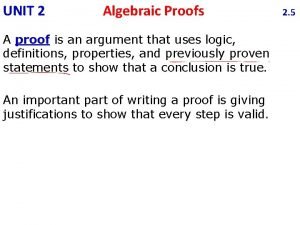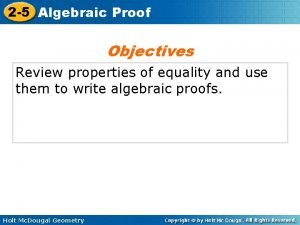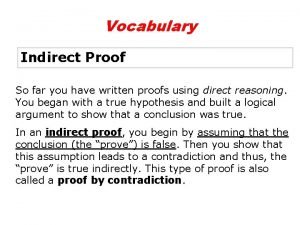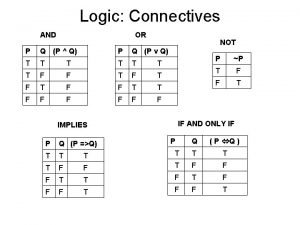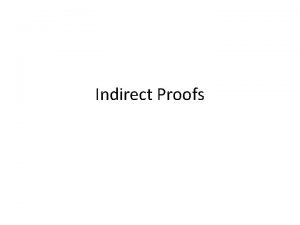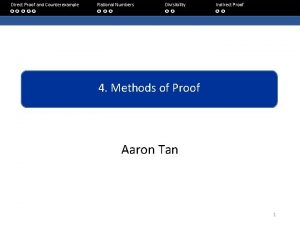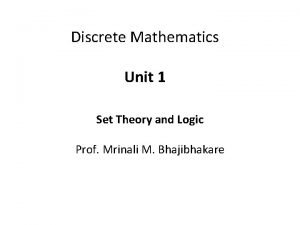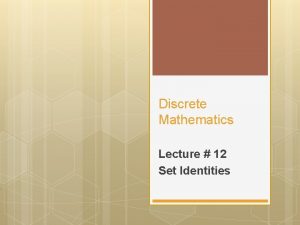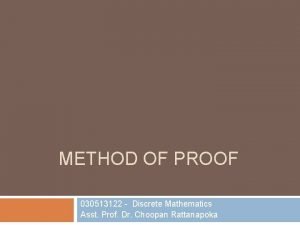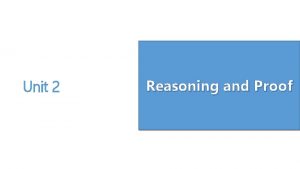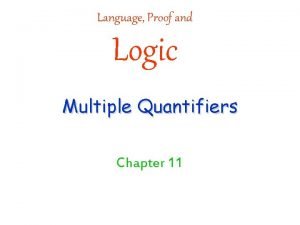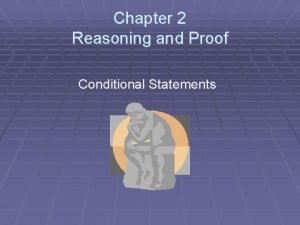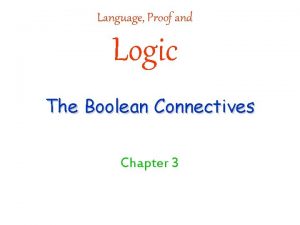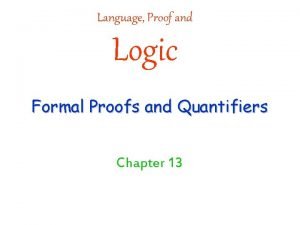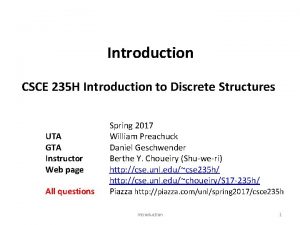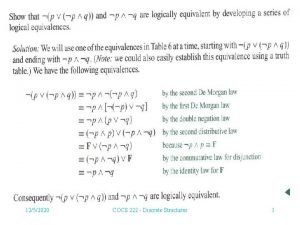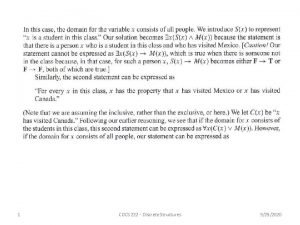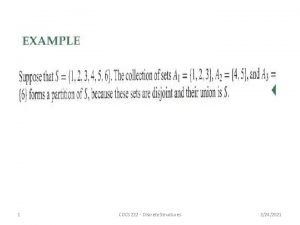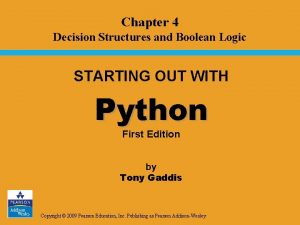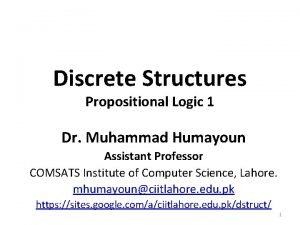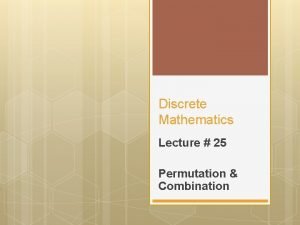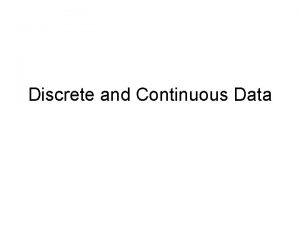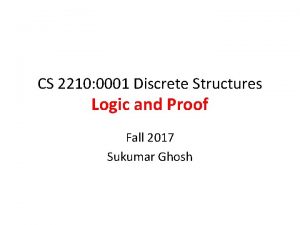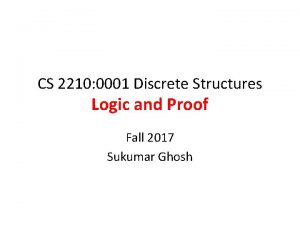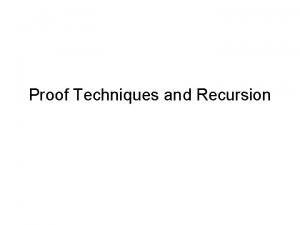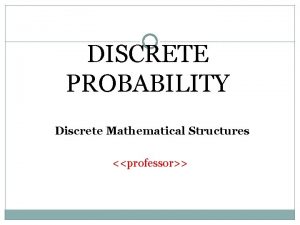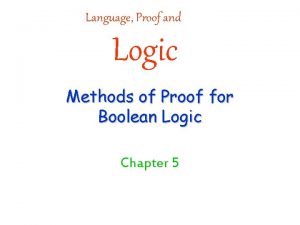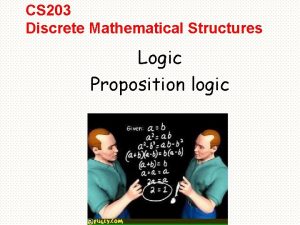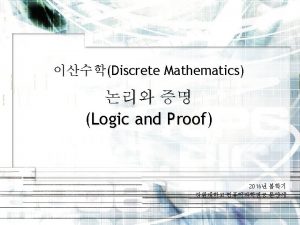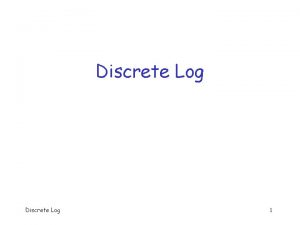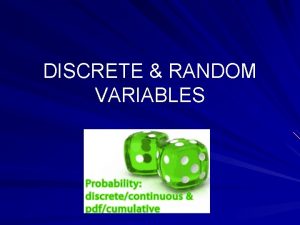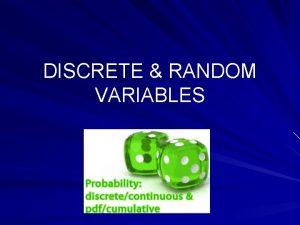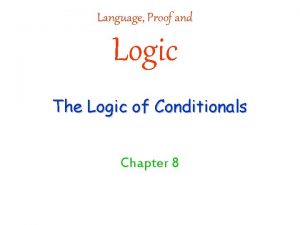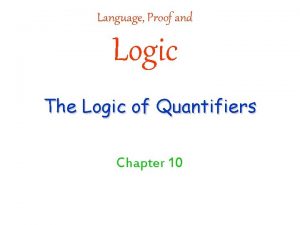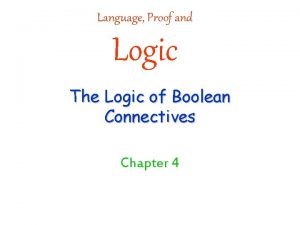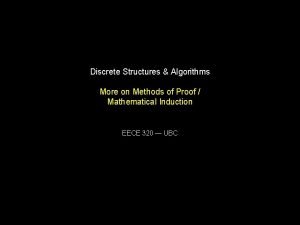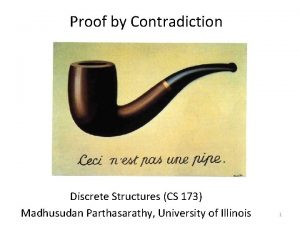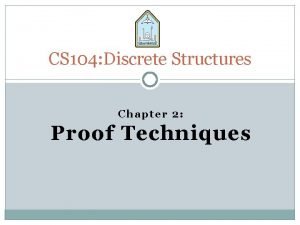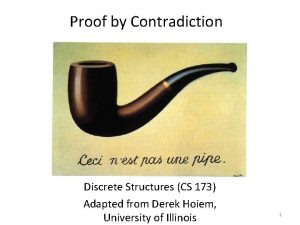22 C 19 Discrete Structures Logic and Proof






















![Other Rules of Inference [(p �q) ⋀ (q �r)] �(p �r) [(p ⋁ q) Other Rules of Inference [(p �q) ⋀ (q �r)] �(p �r) [(p ⋁ q)](https://slidetodoc.com/presentation_image_h/1b93c9af50bf8a535ba8be8021ab1b74/image-23.jpg)



















- Slides: 42

22 C: 19 Discrete Structures Logic and Proof Fall 2014 Sukumar Ghosh

Predicate Logic Propositional logic has limitations. Consider this: Is x > 3 a proposition? No, it is a predicate. Call it P(x). P(4) is true, but P(1) is false. P(x) will create a proposition subject predicate when x is given a value. Predicates are also known as propositional functions. Predicate logic is more powerful than propositional logic

Predicate Logic

Examples of predicates

Quantifiers

Universal Quantifiers

Universal Quantifiers Perhaps we meant all real numbers.

Universal Quantifiers

Universal Quantifiers

Existential Quantifiers ∃x (x is a student in 22 C: 19 �x has traveled abroad)

Existential Quantifiers Note that you still have to specify the domain of x. Thus, if x is Iowa, then P(x) = x+1 > x is not true.

Existential Quantifiers

Negating quantification

Negating quantification You

Translating into English Every student x in this class has studied Calculus. Let C(x) mean “x has studied Calculus, ” and S(x) mean “x is a student in this class. ”

Translating into English

Translating into English

Translating into English

Order of Quantifiers

Negating Multiple Quantifiers

More on Quantifiers ∀x ∃y ( x + y = 10 ) ∀x ∀y ( x + y = y+ x ) Negation of ∀x P(x) is ∃x (P(x) is false) (there is at least one x such that P(x) is false) Negation of ∃x P(x) is ∀x (P(x) is false) (for all x P(x) is false)

Rules of Inference p p �q q (Let p be true) (if p then q) (therefore, q is true) Corresponding tautology [p ⋀ (p�q)] �q What is an example of this?
![Other Rules of Inference p q q r p r p q Other Rules of Inference [(p �q) ⋀ (q �r)] �(p �r) [(p ⋁ q)](https://slidetodoc.com/presentation_image_h/1b93c9af50bf8a535ba8be8021ab1b74/image-23.jpg)
Other Rules of Inference [(p �q) ⋀ (q �r)] �(p �r) [(p ⋁ q) ⋀ ¬ p] �q (p ⋀ q) �p [(p ⋁ q) ⋀ (¬ p ⋁ r) �q ⋁ r (if p is false then q holds, and if p is true then r holds) Find example of each Read page 72 of the book

Rules of Inference ¬q p q ¬p (Let q be false) (if p then q) (therefore, p is false) Corresponding tautology [¬ q ⋀ (p q)] ¬ p What is an example of this?

Proofs To establish that something holds. Why is it important? What about proof by example, or proof by simulation, or proof by fame? Are these valid proofs?

Direct Proofs

Direct Proofs Example. Prove that if n is odd then n 2 is odd. Let n = 2 k + 1, so, n 2 = 4 k 2 + 4 k + 1 = 2 (2 k 2 + 2 k) + 1 By definition, this is odd. Uses the rules of inference

Indirect Proofs

Indirect Proof Example

Proof by Contradiction

Proof by contradiction: Example Assume that the statement of theorem is false. Then show that something absurd will happen Example. If 3 n+2 is odd then n is odd Assume that the statement is false. Then n= 2 k. So 3 n+2 = 3. 2 k + 2 = 6 k+2 = 2(3 k + 1). But this is even! A contradiction! This concludes the proof.

Proof by contradiction: Example

Proof by contradiction: Example. Prove that square root of 2 is irrational. Assume that the proposition is false. Then square root of 2 = a/b (and a, b do not have a common factor) So, 2 = a 2/b 2 So, a 2 = 2 b 2. Therefore a 2 is even. So a = 2 c So 2 b 2 = 4 c 2. Therefore b 2 = 2 c 2. Therefore b 2 is even. This means b is even. Therefore a and b have a common factor (2) But (square root of 2 = a/b) does not imply that.

Exhaustive proof

Exhaustive proof Example 1. If n is a positive integer, and n ≤ 4, then (n+1) ≤ 3 n Prove this for n = 1, n = 2, n = 3, and n = 4, and you are done! Note. An exhaustive proof examines every possible case to establish the proof of the claim. Example 2. Every student of this class has a smartphone. Check with every student of this class to prove it.

Proof of Equivalence

Existence Proofs Constructive Proof Non-constructive Proof

Mistakes in proofs a=b So, a 2 = ab Therefore a 2 - b 2 = ab – b 2 So, (a+b). (a-b) = b. (a-b) Therefore a+b = b So, 2 b = b This implies 2 = 1 What is wrong here?

Counterexample Given a predicate P, if you find a single counterexample to it, then the predicate P is false. Example (of a wrong claim) If n 2 is positive then n is positive To prove it wrong, just show that when n 2=4, n can be -2. Once upon a time, there was a claim that if (2 n-1) divided by n produces the remainder 1, then n is an odd prime. The claim was later found to be false, when someone found a counterexample: the predicate is true for n=341, but 341 is not a prime number (11 x 31 = 341)

Proofs of tiling problems (a) Two dominoes (b)

Proofs of tiling problems (d) (c) (a) (b) 1. Can you tile board (a) with the dominoes of type (c)? 2. Can you tile board (a) (with one corner square removed) with the dominoes of type (c)? 3. Can you tile board (a) (with the top left and the bottom right corner squares removed) with the dominoes of type (c)?

Difficult problems Fermat’s last theorem The equation xn + y n = z n does not have an integer solution for x, y, z when x ≠ 0 , y ≠ 0 , z ≠ 0 and n > 2 (The problem was introduced in 1637 by Pierre de Fermat. It remained unsolved since the 17 th century, and was eventually solved around 1990 by Andrew Wiles)
 Algebraic proofs practice
Algebraic proofs practice 2-5 algebraic proof
2-5 algebraic proof Indirect proof assumption
Indirect proof assumption Direct proof and indirect proof
Direct proof and indirect proof Steps in writing direct proof
Steps in writing direct proof Direct proof and indirect proof
Direct proof and indirect proof Laws of set theory in discrete mathematics
Laws of set theory in discrete mathematics What is tautology in math
What is tautology in math A-b discrete math
A-b discrete math Pqqpq
Pqqpq Angle addition postulate proof
Angle addition postulate proof Chapter 2 reasoning and proof answer key
Chapter 2 reasoning and proof answer key Language proof and logic
Language proof and logic Language proof and logic solutions chapter 11
Language proof and logic solutions chapter 11 Unit 2 logic and proof homework 3 conditional statements
Unit 2 logic and proof homework 3 conditional statements Language proof and logic
Language proof and logic Language, proof and logic
Language, proof and logic Human arm and whale flipper function
Human arm and whale flipper function 2110200
2110200 What is discrete math
What is discrete math Discrete computational structures
Discrete computational structures Discrete structures
Discrete structures Discrete structures
Discrete structures Discrete structures
Discrete structures Python decision structures
Python decision structures Discrete math propositional logic
Discrete math propositional logic Logical equivalence table
Logical equivalence table Proposition math
Proposition math Digital logic structures
Digital logic structures First order logic vs propositional logic
First order logic vs propositional logic First order logic vs propositional logic
First order logic vs propositional logic Third order logic
Third order logic Combinational logic circuit vs sequential
Combinational logic circuit vs sequential Cryptarithmetic problem logic+logic=prolog
Cryptarithmetic problem logic+logic=prolog Combinational logic sequential logic 차이
Combinational logic sequential logic 차이 Is it x y or y x
Is it x y or y x Combinational logic sequential logic 차이
Combinational logic sequential logic 차이 If x = 0 and y = 1, which output line is enabled?
If x = 0 and y = 1, which output line is enabled? Euler circuit
Euler circuit Discrete vs continuous variable
Discrete vs continuous variable Permutation and combination in discrete mathematics
Permutation and combination in discrete mathematics Correspondence function examples
Correspondence function examples Classify each set of data as discrete or continuous
Classify each set of data as discrete or continuous
